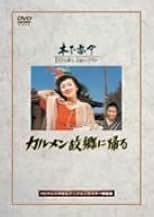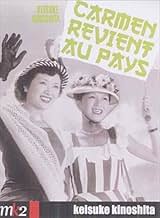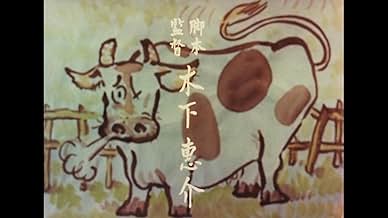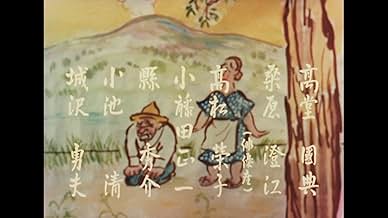Adicionar um enredo no seu idiomaA girl who had left her home village for life in Tokyo returns to her home years later, and evokes a scandal when the locals discover that she's a stripper.A girl who had left her home village for life in Tokyo returns to her home years later, and evokes a scandal when the locals discover that she's a stripper.A girl who had left her home village for life in Tokyo returns to her home years later, and evokes a scandal when the locals discover that she's a stripper.
- Prêmios
- 1 vitória no total
Avaliações em destaque
As perhaps befits the first Japanese color film the visual elements linger in the mind far longer and more brightly than the story elements. One remembers the pastel dresses of the two visiting Tokyo strippers set against the greens and browns of the austere mountain/ranch location and all presided over by a benign volcano long after the way too cutesy rustic comedy stuff is forgotten. Give it a B minus.
When I saw "Carman Comes Home" some years ago it struck me as a gentle and well played comedy on familiar themes. The striking thing, as it was the first Japanese Color film, was the photography which was memorable. It seemed on a par with classics of the era and recalled Michael Powell's best films. I would recommend it to anyone, and I hope a version subtitled into English comes to DVD soon. There are so many good to wonderful Japanese films of the classic era this one should not be lost in the shuffle. I saw it at the Japan Center in Los Angeles. There were once several great Japanese movie theaters in L.A.
Part of the fun of following the Japanese greats, however, is that a lot are hard to see and you have to wait for special screenings.
Part of the fun of following the Japanese greats, however, is that a lot are hard to see and you have to wait for special screenings.
In a tiny mountain village where the children are taught to dance to a dirge-like town anthem, comes news that Hideko Takamine is coming home for a visit, since her theater is closed for a week, and bringing her friend, Toshiko Kobayashi. Her father, Takeshi Sakamoto, want to forbid it, even though she has sent home gifts and money since she ran away at 18; he can only imagine how corrupting Tokyo is. However, the school principal, Chishû Ryû, gives him a long lecture about art and culture, and he gives way. The girls are a little strange, showing too much leg, and it isn't until halfway through what seems to be Japan's first color movie that the village discovers the girls' art is the strip-tease.
It must have been a nice change of pace for one of Japan's leading actresses of feminist roles to play a ditzy stripper, but she appears to be having more fun in the part than this rather mild movie calls for. It's mostly about the characters in the small town; as I so often am, I am once again astounded at exactly the same sort of people cropping up in mountainous Japan as in small-town Indiana or Italy, with the same sort of story that might star Mitzi Gaynor or Diana Dors -- you choose your own Continental actress for the part. Keisuke Kinoshita directs facilely, if not deeply, Kiroshi Kusuda handles the color camera as well as he ever did the black & white model, and the mountain scenery is quite lovely. It's clearly a movie where they played it cannily, and the financial results seem to have been good enough to justify a sequel the next year. I'm sure that, having been a child actress on a movie lot at 5, Miss Takamine enjoyed showing a bitof adult skin .... and roaring at Miss Sakamoto like she was Toshiro Mifune.
It must have been a nice change of pace for one of Japan's leading actresses of feminist roles to play a ditzy stripper, but she appears to be having more fun in the part than this rather mild movie calls for. It's mostly about the characters in the small town; as I so often am, I am once again astounded at exactly the same sort of people cropping up in mountainous Japan as in small-town Indiana or Italy, with the same sort of story that might star Mitzi Gaynor or Diana Dors -- you choose your own Continental actress for the part. Keisuke Kinoshita directs facilely, if not deeply, Kiroshi Kusuda handles the color camera as well as he ever did the black & white model, and the mountain scenery is quite lovely. It's clearly a movie where they played it cannily, and the financial results seem to have been good enough to justify a sequel the next year. I'm sure that, having been a child actress on a movie lot at 5, Miss Takamine enjoyed showing a bitof adult skin .... and roaring at Miss Sakamoto like she was Toshiro Mifune.
For years, I had thought that Teinosuke Kinugasa's GATE OF HELL (1953) was Japan's first color movie. I had read that somewhere as a film student many years ago and in all this time I never came across any mention of earlier Japanese color films. Until this year. In reading Yoshihiro Tatsumi's autobiographical manga, "A Drifting Life," I stumbled upon a reference to CARMEN COMES HOME (1951), described in the manga as "Japan's first color film." Needless to say, I was astounded by this discovery and began looking for more information about it. Some of the reference sources I have do indeed accurately cite this film, so I have no idea where I came across that original erroneous mention of GATE OF HELL. Eager to see CARMEN COMES HOME, I asked around on the web and got word that YesAsia was selling it on DVD-with English subtitles-so I bought it.
The previous review, by "toclement," touches on many of the film's virtues in as concise a manner as you're likely to find on IMDb, so I hope not to repeat what was said, but simply to add to it. The most important aspect of the film for me is, of course, the color cinematography, beautifully captured in this expert DVD transfer. (According to the book, "The Japanese Film: Art and Industry," by Joseph L. Anderson and Donald Richie, the process used was Fujicolor.) The film was shot almost entirely on location in a farm town at the foot of Mount Asama, an active volcano on the central Japanese island of Honshu. Many of the shots are framed with Mount Asama majestically rising in the background, with steam sometimes seen escaping from the volcano. There are hilltops and green meadows abounding where the lead character, Carmen, accompanied by her friend, Maja, takes off her shoes and runs through the grass, dancing and frolicking in bursts of spontaneous joy. Nearly every shot is drenched in sunlight and the bright colors of Carmen's and Maja's costumes and the redness of their lipstick dazzle the viewer in every scene. Adding to the splendor is the way Carmen bursts into song, entirely on her own, in scene after scene. She may be visiting her childhood hometown for the first time in years, but she's wrapped up in her own self-created universe and she takes it with her wherever she goes.
It's quite unlike any other Japanese film I've seen. Most Japanese films I see have urban settings or historical settings or are science fiction films set in the future, on spaceships or on other planets. Rarely have I seen films about contemporary rural life in Japan, especially in color. And this film shows us numerous details about small town life in Japan and the people who live it. As the previous reviewer indicated, the film never seeks to judge its characters (with one notable exception), but simply presents them to us as they are, warts and all. It's an amusing film, with lots of humorous behavior, but it's never condescending. It's also never laugh-out-loud funny, precisely because it avoids the contrivances, farcical touches and melodramatic highs and lows that characterize traditional movie comedy. The humor arises from obvious collisions between the manners of aggressive citified showgirls and those of the more laidback country folk. In one scene, Maja flirts quite openly with Mr. Ogawa, the young schoolteacher. His reaction? He complains to Carmen's amused brother-in-law that Maja was "bullying" him. Carmen herself is a flamboyant character, but she's never larger than life. We come to understand her, particularly after her father offers a revelation about a childhood incident that might account for her behavior. She's not the sharpest knife in the drawer and would surely be quite a handful in any relationship, but she's still cute, endearing and fun to take in small doses.
The one character on whom the film casts judgment is Maruju, the local businessman who pretty much runs the town. He sees himself as a beneficent entrepreneur, seeking to promote art and culture when he offers to let Carmen and Maja perform their racy dance act for the town-for 100 yen a ticket! He is berated by Carmen's father and the school principal, but, in the end, Maruju's not such a bad sort after all. In fact, it was always Carmen's dream to find a way to share her "art" with her hometown audience. Which she does, most memorably. And a handful of characters benefit in varying, but important ways. And it's Maruju who makes it possible.
The film is filled with character types familiar from Japanese films. The school principal, played by Chishu Ryu, famous for his roles in Yasujiro Ozu's films, is something of a caricature, a rigid defender of Japanese culture and tradition, like someone out of the 19th century, who comes to regret his initial endorsement of Carmen's visit. A running gag has him turning to Mount Asama to sing traditional folk songs in praise of the mountain. Still, these characters are all far less exaggerated than they would have been in a similarly-themed Hollywood comedy, the kind in which everybody would have been transformed in some way by Carmen's visit. (Mae West may have made something in that vein in the post-pre-Code 1930s.) In this film, the town is left with a couple of subtle positive effects, but Carmen is no different when she leaves than when she arrived.
I've seen a handful of other Japanese color films made in the 1950s, including GATE OF HELL (1953), the SAMURAI trilogy (1955), JANKEN MUSUME (1955, also reviewed on this site), RODAN (1957), OHAYO (1959), and THE MYSTERIANS (1959). Now I'd like to see more. [UPDATE: I've seen many more color Japanese films from the 1950s in the 12 years since I did this review, from many different genres, some of which I've reviewed here. TCM will be running this film on the morning of April 4, 2022, which is why I came back to check my review.)
The previous review, by "toclement," touches on many of the film's virtues in as concise a manner as you're likely to find on IMDb, so I hope not to repeat what was said, but simply to add to it. The most important aspect of the film for me is, of course, the color cinematography, beautifully captured in this expert DVD transfer. (According to the book, "The Japanese Film: Art and Industry," by Joseph L. Anderson and Donald Richie, the process used was Fujicolor.) The film was shot almost entirely on location in a farm town at the foot of Mount Asama, an active volcano on the central Japanese island of Honshu. Many of the shots are framed with Mount Asama majestically rising in the background, with steam sometimes seen escaping from the volcano. There are hilltops and green meadows abounding where the lead character, Carmen, accompanied by her friend, Maja, takes off her shoes and runs through the grass, dancing and frolicking in bursts of spontaneous joy. Nearly every shot is drenched in sunlight and the bright colors of Carmen's and Maja's costumes and the redness of their lipstick dazzle the viewer in every scene. Adding to the splendor is the way Carmen bursts into song, entirely on her own, in scene after scene. She may be visiting her childhood hometown for the first time in years, but she's wrapped up in her own self-created universe and she takes it with her wherever she goes.
It's quite unlike any other Japanese film I've seen. Most Japanese films I see have urban settings or historical settings or are science fiction films set in the future, on spaceships or on other planets. Rarely have I seen films about contemporary rural life in Japan, especially in color. And this film shows us numerous details about small town life in Japan and the people who live it. As the previous reviewer indicated, the film never seeks to judge its characters (with one notable exception), but simply presents them to us as they are, warts and all. It's an amusing film, with lots of humorous behavior, but it's never condescending. It's also never laugh-out-loud funny, precisely because it avoids the contrivances, farcical touches and melodramatic highs and lows that characterize traditional movie comedy. The humor arises from obvious collisions between the manners of aggressive citified showgirls and those of the more laidback country folk. In one scene, Maja flirts quite openly with Mr. Ogawa, the young schoolteacher. His reaction? He complains to Carmen's amused brother-in-law that Maja was "bullying" him. Carmen herself is a flamboyant character, but she's never larger than life. We come to understand her, particularly after her father offers a revelation about a childhood incident that might account for her behavior. She's not the sharpest knife in the drawer and would surely be quite a handful in any relationship, but she's still cute, endearing and fun to take in small doses.
The one character on whom the film casts judgment is Maruju, the local businessman who pretty much runs the town. He sees himself as a beneficent entrepreneur, seeking to promote art and culture when he offers to let Carmen and Maja perform their racy dance act for the town-for 100 yen a ticket! He is berated by Carmen's father and the school principal, but, in the end, Maruju's not such a bad sort after all. In fact, it was always Carmen's dream to find a way to share her "art" with her hometown audience. Which she does, most memorably. And a handful of characters benefit in varying, but important ways. And it's Maruju who makes it possible.
The film is filled with character types familiar from Japanese films. The school principal, played by Chishu Ryu, famous for his roles in Yasujiro Ozu's films, is something of a caricature, a rigid defender of Japanese culture and tradition, like someone out of the 19th century, who comes to regret his initial endorsement of Carmen's visit. A running gag has him turning to Mount Asama to sing traditional folk songs in praise of the mountain. Still, these characters are all far less exaggerated than they would have been in a similarly-themed Hollywood comedy, the kind in which everybody would have been transformed in some way by Carmen's visit. (Mae West may have made something in that vein in the post-pre-Code 1930s.) In this film, the town is left with a couple of subtle positive effects, but Carmen is no different when she leaves than when she arrived.
I've seen a handful of other Japanese color films made in the 1950s, including GATE OF HELL (1953), the SAMURAI trilogy (1955), JANKEN MUSUME (1955, also reviewed on this site), RODAN (1957), OHAYO (1959), and THE MYSTERIANS (1959). Now I'd like to see more. [UPDATE: I've seen many more color Japanese films from the 1950s in the 12 years since I did this review, from many different genres, some of which I've reviewed here. TCM will be running this film on the morning of April 4, 2022, which is why I came back to check my review.)
This was the very first color film made in Japan. It's a relatively simple tale about a small remote village that rests at the foot of a volcano. The people are simple and life is uncomplicated here, even if the people struggle to make ends meet.
Things get interesting when the daughter (Karumen, or Carmen) of one of the townsmen decides that she will be returning for a visit. She had left the village years ago in search of greener pastures in the big city (Tokyo) where she has become a famous dancer. The townspeople have only heard about her celebrity but don't really have a clue as to the content of what has made her famous. It turns out that her performances border on the risque and she is essentially a high-class exotic dancer. Scandal erupts in the town as this fact comes to light.
Now one might assume that with this plot, the logical thing to have happen is that Karumen realizes all the wonderful things she gave up in the small village and that her life in Tokyo as an exotic dancer is hollow. But this being a Japanese movie, it doesn't follow that cliched convention. Instead the message from the film is complex and can be interpreted in many ways: perhaps one man's exotic dancer is another man's performance art; or the world needs exotic dancers to attract more general attention to the arts; or people should be free to decide what type of performance they want to put on and people should be free to decide what type of performance they wish to watch; or maybe in fact while the exotic dancer gets a big audience (and money), her life is indeed hollow compared to the poor (and blind) harmonium player in the village.
At any rate, the movie does not give you a simple and easily interpretable message. Instead it only provides you with many thoughts and leaves it for you to decide what message you think you should take away. This is such a lost art in filmmaking, particularly in today's Hollywood in-your-face heavy-handed manner of giving the audience the 'message'. What's also interesting in the film is the complexity of the characters. They do good things and bad things at different times, and while some might be better than others, no characters are always good, and neither are any always bad. This certainly more accurately reflects real human behavior and again is something that is often missing from mainstream American cinema.
In sum, I think that this film is certainly worth a look, and while it is not likely to blow you away, it is well worth watching for historical reasons, for some magnificent scenery, some intriguing musical numbers and choreography, and for seeing a different way to tell a story in film. 8 out of 10.
Things get interesting when the daughter (Karumen, or Carmen) of one of the townsmen decides that she will be returning for a visit. She had left the village years ago in search of greener pastures in the big city (Tokyo) where she has become a famous dancer. The townspeople have only heard about her celebrity but don't really have a clue as to the content of what has made her famous. It turns out that her performances border on the risque and she is essentially a high-class exotic dancer. Scandal erupts in the town as this fact comes to light.
Now one might assume that with this plot, the logical thing to have happen is that Karumen realizes all the wonderful things she gave up in the small village and that her life in Tokyo as an exotic dancer is hollow. But this being a Japanese movie, it doesn't follow that cliched convention. Instead the message from the film is complex and can be interpreted in many ways: perhaps one man's exotic dancer is another man's performance art; or the world needs exotic dancers to attract more general attention to the arts; or people should be free to decide what type of performance they want to put on and people should be free to decide what type of performance they wish to watch; or maybe in fact while the exotic dancer gets a big audience (and money), her life is indeed hollow compared to the poor (and blind) harmonium player in the village.
At any rate, the movie does not give you a simple and easily interpretable message. Instead it only provides you with many thoughts and leaves it for you to decide what message you think you should take away. This is such a lost art in filmmaking, particularly in today's Hollywood in-your-face heavy-handed manner of giving the audience the 'message'. What's also interesting in the film is the complexity of the characters. They do good things and bad things at different times, and while some might be better than others, no characters are always good, and neither are any always bad. This certainly more accurately reflects real human behavior and again is something that is often missing from mainstream American cinema.
In sum, I think that this film is certainly worth a look, and while it is not likely to blow you away, it is well worth watching for historical reasons, for some magnificent scenery, some intriguing musical numbers and choreography, and for seeing a different way to tell a story in film. 8 out of 10.
Você sabia?
- CuriosidadesThe first Japanese color film.
- Erros de gravaçãoWhen Carmen and Maya are in the field and Carmen shoves Maya, the camera cuts to a closeup of Maya looking upset, but in the shot before she can be seen laughing under the brim of her hat as Carmen knocks her down.
- Citações
The principal: It's a violation of human rights to go against her will to dance. Nowadays, profiteering evils like bicycle racing are allowed to flourish. Maruju's scheme for a nude dance show may be less offensive in comparison.
- ConexõesFeatured in Verão com Estranhos (1988)
Principais escolhas
Faça login para avaliar e ver a lista de recomendações personalizadas
Detalhes
- Tempo de duração1 hora 26 minutos
- Mixagem de som
- Proporção
- 1.37 : 1
Contribua para esta página
Sugerir uma alteração ou adicionar conteúdo ausente




























